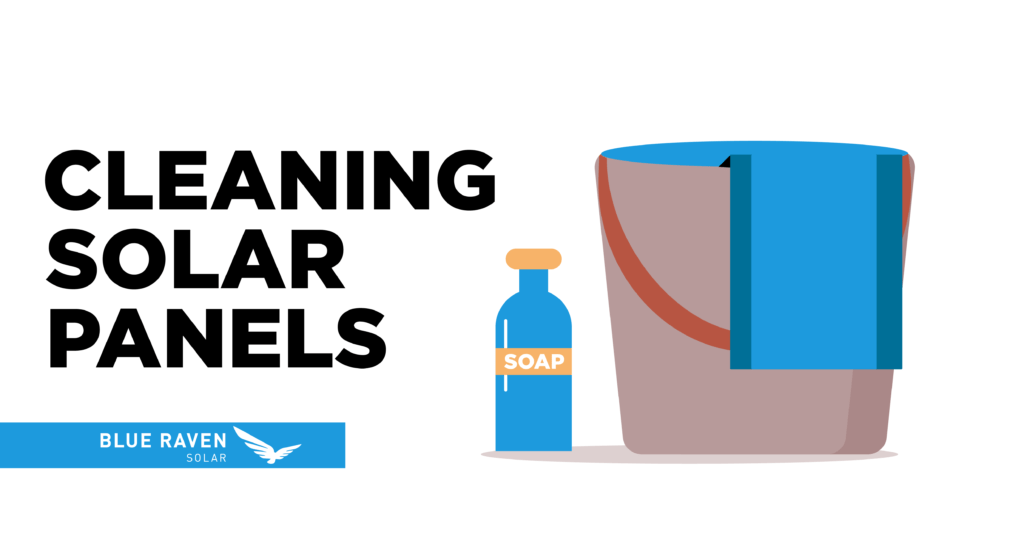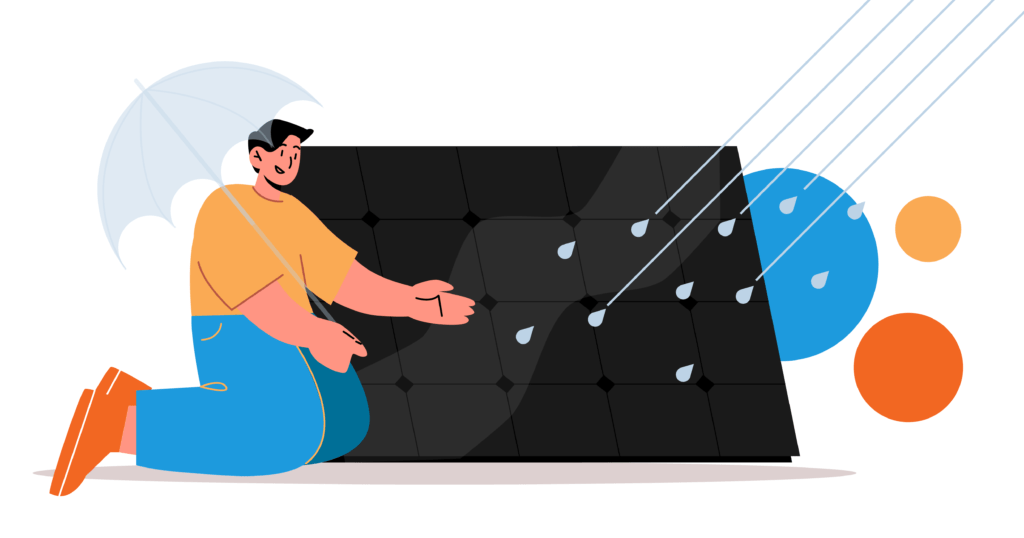

CAUTION: READ MANUFACTURER INSTALLATION, SAFETY, AND MAINTENANCE INSTRUCTIONS BEFORE CLEANING OR MAINTAINING YOUR SOLAR PANELS. PARTICIPATING IN SUCH ACTIVITIES INVOLVES THE EVER-PRESENT RISK OF PERSONAL INJURY, PROPERTY DAMAGE, AND LOSS. THE USE OF HARSH, INDUSTRIAL-STRENGTH CLEANING MATERIAL OR SHARP INSTRUMENTS TO CLEAN OR MAINTAIN YOUR SOLAR PANELS MAY VOID PRODUCT GUARANTEES OR WARRANTIES.
Do solar panels need regular cleaning to maintain top efficiency or does the occasional rainstorm get the job done?
The truth is it depends. In some cases, rain or snow may clean most of the dust buildup, but in certain conditions, it could do more harm than good. In both dry and humid climates — environmental factors, different types of pollutants, geographic location, and installation factors will all influence:
- How much dust will be collected over time
- How much of an impact dust buildup will have on the energy production of solar panels
- Whether rainfall will wash the dust off enough to restore panels to at least 95 percent of top performance levels

Does rain help remove dust? How much rain is needed?
In a study conducted in Spain, researchers measured an average performance reduction of only 4.4 percent after a year’s worth of dust buildup. Most solar panel owners could probably live with this amount, but the study also found in “long periods without rain, daily energy losses can be higher than 20%.”1 So, in dry climates like Nevada, Arizona, and Utah, where dust buildup is the main issue, the problem remains simple: a lack of rain results in dust buildup getting progressively worse the longer the dry spell lasts.
Meanwhile, regular rainfall can rinse away dust and keep solar panels producing around 95% of their maximum capacity. You might assume solar panels in climates with frequent rainfall would require less maintenance, but not so fast! Most of the time there’s more to the equation than just dust. Pollen, bird droppings, leaves, ash, and a hazy film can form when smog or smoke hangs heavily in the atmosphere. All of these natural elements combine into a layer of surface soiling, which may or may not wash away in the rain. A report from Renewable and Sustainable Energy Reviews2 digs deeper into the complex variables involved. The research concludes allowing rain to do the work of cleaning solar panels is a fine decision if you live in the right place, such as:
- A place where dust makes up most of the buildup that forms on solar panels
- A place where the makeup of the dust is such that rain will effectively wash it away
- A place where it rains with the right frequency to keep dust buildup from depleting the energy production of solar panels
Think about it: if rain was really an effective method of cleaning, then why is the car wash everyone’s first stop when a rainstorm ends? With the wrong combination of pollutants, a little rain might not clean anything. It could become the base ingredient combining a collection of contaminants into a slurry.
Case in point: the account of one customer living in a temperate rainforest where the climate completely rules out dust as a problem. Three years after installing their solar panels, they noticed a 10% performance drop. When they called local installers to ask about cleaning services, they got a canned answer about how the frequency of rain in their area should prevent any significant buildup from forming. However, when a window washer who they hired went to clean their panels, he found a sticky brown haze that would not likely rinse off in the rain. Once the panels were cleaned, the homeowner claimed productivity increased by 20%, exceeding their original production level by 10%!3
If rain will not do the trick, how do you determine if cleaning your panels is worthwhile?
If you have had solar panels installed and energized for a while—a year, maybe more—you have most likely noticed how the energy production varies from month to month due to weather changes and the sun’s position overhead as the seasons progress.
With a little bit of experience monitoring your solar array, you will learn how much fluctuation to expect over the course of a year. If you start noticing reduced output at a time when weather patterns seem on par with what you have come to expect, dirty panels could be the main factor. When it happens, consider these questions:
- Do your panels lie flat—between zero and five degrees? They may accumulate more surface soiling than panels at a larger degree.
- Do you live downwind from a highway, airport, or farmland? If you answered yes to any of the following, the air in your area may carry high amounts of dust.
- Is rainfall sparse enough to allow heavy dust buildup? Your panels may need to be sprayed off with water.
- Do you live in an area prone to pollution from industrial smog or wildfire smoke? If your home or local area has experienced large amounts of smog or wildfire smoke, you may find a hazy film on the surface of your solar panels that may not rinse off.
- Is your house surrounded by tall trees? Having trees covering your panels may result in a buildup of fallen leaves and/or bird droppings on your panels.
- Have you come through a season of high pollen count? You may find a sticky residue preventing rain from washing dirt and dust away.
- Is your local climate humid enough for moss to grow around your home? You cannot assume rain is going to keep your panels clean—rain could be the problem.
Ideally, you want to clean your panels in a way that tips the balance between cost, effort, and the potential efficiency improvements in your favor. If it seems clear your panels need to be cleaned one way or another, the next step is to determine the best step forward. Consider this next list of questions, based on your observations.
- Does the buildup seem to be mostly dust or are there more sticky substances like bird droppings, pollen, and smoke involved?
- Is it possible to spray your panels off with a garden hose from the ground or will you need a ladder?
- Is there a safe way—either by ladder or otherwise—to climb onto your roof, if necessary?
- Are your panels mounted far enough from the edges of the roof that you can move around and position yourself to safely reach each one?
- Do your roofing materials and roof pitch create a safe platform to work from? Or is it too high, steep, fragile, and/or slippery?

Tips on Cleaning Solar Panels
Cleaning your solar panels shouldn’t cost an excessive amount, nor should it be an overly complicated process. When possible, spraying them off from the ground with a garden hose is easiest and least intrusive. But the stickier the buildup, the more likely it is you will need to hire professionals or purchase specific cleaning tools and supplies to wipe your panels down.
For minimal surface soiling made up mostly of dust, try hosing your solar panels off from the ground.
If your panels seem to be underperforming, your roof isn’t too high, and your consideration of environmental factors leads you to conclude a simple accumulation of dust is likely the problem, try hosing your panels off from the ground first. It’s the safest, easiest, and most low-cost solution — which makes it the one with the highest in return.
Just remember, if your roof is low enough to be sprayed from the ground but high enough to require a pressure washer or a nozzle to concentrate the hose pressure, do not blast your solar panels directly with harsh, high-pressure pulses of water. Hitting the dirty surface with high pressure may create scratches. Scratches will cast tiny shadows on the photovoltaic cells underneath the tempered glass layer, permanently depleting the energy output of your solar panels.
For heavier buildup, use soft scrubbers, mild soapy water, and a squeegee to wash your solar panels.
Cleaning supplies you will need:
- A soft brush and squeegee long enough to reach from wherever you will be working.*
- A water hose long enough to reach all of your panels.
- A bucket filled with a 3% soap-and-water solution.**
*Pro Tip: If you do not have adequate tools on hand, you can find inexpensive, all-in-one, window washing tools with a soft scrubber to gently clean glass on one side, and a squeegee on the other mounted on an extendable pole, like this.
**Pro Tip: You can find specialty, biodegradable solar panel cleaners, like this, packaged in a disposable hose mixing sprayer.
Recommended Cleaning Process:
- Fill your bucket with a 3% soap-and-water solution.
- Rinse solar panels with clean water to clear away loose dirt.
- Use soft scrubber and soapy water from the bucket—or mixing sprayer—to gently wash the surface of the panels.
- Rinse solar panels with clean water from the hose a second time.
- Squeegee panels dry.
- Follow the same process, changing your position as needed, until all panels are clean.***
***Pro Tip: Be careful to avoid touching the sides or underside. Also, avoid contact with any wiring harnesses and/or cables.
It is important to remember solar panels get hot in the middle of the day, so it is best to schedule your cleaning time at dawn, dusk or on an overcast day when the surface will be relatively cool. If you were to rinse your panels with soapy water while they are hot, the water would instantly evaporate, creating a film requiring additional cleaning steps to remove.
In the same vein, wintertime will bring colder evenings and snow. Helping snow off of your panels is safest and warmest during the daytime when the sun is out, though with the angle of the panels plus the smooth surface, snow likely will not need any help melting off.

Sometimes it is cheaper, safer, and easier to call professional cleaners.
Maybe you have considered the variables involved, taken stock of the resources you have at hand, and concluded cleaning your solar panels on your own is not for you. For example, you have realized:
- Your roof is too high, too steep, or too slippery to walk on.
- You do not have a ladder tall enough or adequate cleaning tools. The idea of buying and storing a bunch of cleaning tools and equipment you may only use once a year makes no sense.
- You have physical limitations, making climbing ladders and scrambling around on rooftops a sketchy proposition.
- You would simply prefer not to be the one who does all the work.
For plenty of solar customers, professional cleaning can be the most worthwhile option. At this point, the choice is to call the company who installed your solar panel system to ask if they offer cleaning services. They should have information regarding your roofing materials, roof pitch, square footage of your solar array, and either photographs or digital renderings of how your solar panels are laid across your roof. It should be very easy for them to give you an accurate estimate over the phone or point you in the right direction.
According to Thumbtack, the national average for cleaning costs is $130-$150. This can change, depending on system size, location, and the cleaners’ hourly rates. Typically, cleaning takes a couple of hours.
Conclusion
Depending on the weather conditions, dust, and other pollutants your panels could accumulate, it is important for you to regularly rinse off your panels, and if necessary, follow the tips outlined above to carefully clean them or hire professional cleaners. Cleaning your solar panels will keep your system operating at maximum efficiency so you can reap the full benefits of going solar year after year.
Footnotes:
[1] 2019. Irishellas.Com. Accessed March 6, 2019. https://www.irishellas.com/files/Analysis-of-dust-losses-in-photovoltaic-modules_2011.pdf.
[2] “Renewable and Sustainable Energy Reviews | Vol 59, Pages 1-1688 (June 2016) | Sciencedirect.Com”. 2019. Sciencedirect.Com. Accessed March 13, 2019. https://www.sciencedirect.com/journal/renewable-and-sustainable-energy-reviews/vol/59/suppl/C.
[3] “I Have to Clean My Solar Panels, And You Probably Do Too | Green Built Alliance”. 2016. Green Built Alliance. Accessed March 6, 2019. https://www.greenbuilt.org/i-have-to-clean-my-solar-panels-and-you-probably-do-too/.



Sorry, the comment form is closed at this time.